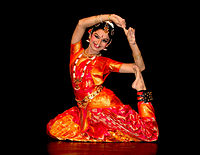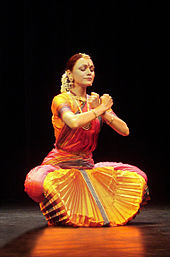婆罗多舞
 | |
| 原文名 | பரதநாட்டியம் (泰米尔语) |
|---|---|
| 词源 | 由泰米尔语中的 bhavam(情感)、ragam(旋律)、thalam(节奏)和 natyam(舞蹈)组成的混成词 |
| 类型 | 印度古典舞 |
| 起源地区 | 印度泰米尔纳德邦 |
婆罗多舞(泰米尔语:பரதநாட்டியம்,拉丁化:Bharatanatyam)是一种源自印度泰米尔纳德邦的古典舞蹈。这种舞蹈的特色是透过舞者的表情手势配以音乐,以哑剧的形式呈现表达印度南部的宗教主题和印度教及耆那教的精神理念。《乐舞论》记载了婆罗多舞的前身,大约可追溯到公元前500年左右。[1][2]此外,泰米尔古典长篇叙事史诗《西拉巴提伽拉姆》也在公元171年左右提及这种舞蹈。[3][4]
而此从6至9世纪的寺庙雕刻则看到,这种舞蹈在公元1千年中期已经发展成一种精致的表演艺术,当时被称为“萨迪拉塔姆舞”(泰米尔语:சதிராட்டம்,Sadiraattam), 是印度最古老的古典舞蹈传统,之后在1932年被更名为婆罗多舞。[5]婆罗多舞在20世纪经过复兴,现已成为印度最重要的古典舞蹈之一,并受印度国家级艺术机构桑吉特‧纳塔克学院认可,同时为泰米尔纳德邦的邦舞。
词源
[编辑]在1932年,艺术家E·克里希纳·艾耶和舞蹈家拉克米妮·达维·埃兰德尔提议将“萨迪拉塔姆舞”更名为“婆罗多舞”,以提升其艺术地位。[6]Bharatam 这个词被视为一个逆向首字母缩略词,其中 bha 代表 bhavam(情感),ra 代表 ragam(旋律),tam 代表 talam(节奏)。[7][8]Natyam 这个词是梵语,意为“舞蹈”。因此,婆罗多舞这个复合词被认为是一种和谐地表达情感、旋律和节奏的舞蹈。[7]
历史
[编辑]
婆罗多舞的理论基础首先见于《乐舞论》,后来在泰米尔语文本《库塔努尔》(Kootha nool)中也有描述。[3][10][11]《乐舞论》被认为是古代学者婆罗多牟尼的作品,其完整编辑版本大约在公元前500年至公元200年间完成。[12][13]婆罗多舞的雕刻和文本在古印度的历史中启发了音乐家、诗人、画家、歌手和雕刻家。婆罗多舞共享了许多古代湿婆雕塑中的舞蹈姿势。[14][15]
服装和服饰
[编辑]
女性婆罗多舞者的服装类似于泰米尔印度新娘的穿着,通常由一件亮色的纱丽组成,并在边缘有金或银的刺绣。男性舞者的服装通常是纱丽或白色棉布,类似于托蒂。所有舞者都佩戴复杂的珠宝,并在手和脚上涂上红色的库姆库玛粉或阿尔塔粉。[16]
元素和象征意义
[编辑]
婆罗多舞传统上是一种团队表演艺术,通常由一名独舞者和音乐家及歌手组成。这种舞蹈被描述为经典艺术,因为其音乐音符、声乐表演和舞蹈动作的理论反映了《乐舞论》和其他梵语及泰米尔语文本的思想。婆罗多舞的基本站姿被称为 Aramandi,包含至少20个现代瑜伽中的姿势。
像印度所有的经典舞蹈一样,婆罗多舞使用象征(Abhinaya)来进行表演和目标。[17]这些象征以表情和手势,配上音乐以哑剧形式呈现。通过这些象征,舞者成功地表达了精神理念,并引起观众的情感共鸣。[17] 婆罗多舞包含至少20个现代瑜伽中的姿势,被认为是一种巴克提瑜伽。[18]
舞者的首演
[编辑]
年轻的婆罗多舞舞者初步正式训练的完成时,会作一场独舞的首演,称为“阿兰吉特兰”(Arangetram)。“阿兰吉特兰”意为“登上舞台”,通常在舞者开始学习婆罗多舞的十至十二年后进行。这个独舞首演象征着“成年礼”,展示了舞者多年来的努力和技能。[20][21]
现代复兴
[编辑]学校和培训中心
[编辑]印度独立后,婆罗多舞迅速扩展,并成为印度最受欢迎的经典舞蹈风格。[22]许多主要城市现在都有提供婆罗多舞课程的学校,每年举办数百场演出。在印度以外,婆罗多舞是许多国家学术机构中受欢迎的研究对象,并在全球印度裔社区中得到广泛支持和学习。[23]
电影
[编辑]婆罗多舞在多部印度电影中被呈现,例如《Senthamarai》(1962年)、《Thillana Mohanambal》(1968年)和《Sagara Sangamam》(1983年)。这些电影展示了婆罗多舞的美丽和技艺,并在全球范围内提升了其知名度。
另见
[编辑]参考文献
[编辑]- ^ Natalia Lidova 1994,第111–113页.
- ^ Richmond, Swann & Zarrilli 1993,第30页.
- ^ 3.0 3.1 Khokar, Mohan. Traditions of Indian Classical Dance. India: Clarion Books. 1984: 73–76.
- ^ James G. Lochtefeld. The Illustrated Encyclopedia of Hinduism: A-M. The Rosen Publishing Group. 2002: 103–104. ISBN 978-0-8239-3179-8.
- ^ Richard Schechner. Between Theater and Anthropology. University of Pennsylvania Press. 2010: 65. ISBN 978-0812279290.
- ^ Amanda J. Weidman. Singing the Classical, Voicing the Modern. Duke University Press. 2006: 120 [2024-06-24]. ISBN 9780822388050. (原始内容存档于2024-07-06).
- ^ 7.0 7.1 Anjani Arunkumar, Compositions for Bharatanāṭyam: A Soulful Worship the Divine, Bharatiya Vidya Bhavan: xxi–xxii, 1989
- ^ Brenda P McCutchen. Teaching Dance as Art in. Human Kinetics. 2006: 450–452. ISBN 978-0-7360-5188-0.
- ^ James G. Lochtefeld. The Illustrated Encyclopedia of Hinduism: A-M
 . The Rosen Publishing Group. 2002: 126–127. ISBN 978-0-8239-3179-8.
. The Rosen Publishing Group. 2002: 126–127. ISBN 978-0-8239-3179-8.
- ^ Eugenio Barba; Nicola Savarese. A Dictionary of Theatre Anthropology: The Secret Art of the Performer. Routledge. 2011: 208 [2024-06-24]. ISBN 978-1-135-17634-1. (原始内容存档于2023-07-03).
- ^ Peter Fletcher; Laurence Picken. World Musics in Context: A Comprehensive Survey of the World's Major Musical Cultures. Oxford University Press. 2004: 262 [2024-06-24]. ISBN 978-0-19-517507-3. (原始内容存档于2023-07-03).
- ^ Natalia Lidova 2014.
- ^ Tarla Mehta 1995,第xxiv, 19–20页.
- ^ Constance Jones; James D. Ryan. Encyclopedia of Hinduism. Infobase Publishing. 2006: 79, 107. ISBN 978-0-8160-7564-5.
- ^ Vidya Dehejia. Art of the Imperial Cholas. Columbia University Press. 2013: 101. ISBN 978-0-231-51524-5.
- ^ Anjani Arunkumar. Compositions for Bharatanāṭyam: A Soulful Worship of the Divine. Bharatiya Vidya Bhavan. 1989: xxi–xxii.
- ^ 17.0 17.1 Tarla Mehta 1995,第3页.
- ^ Tanvi Bajaj; Swasti Shrimali Vohra. Performing Arts and Therapeutic Implications. Routledge. 2015: 82–84. ISBN 978-1-317-32572-7.
- ^ Shivam Natyalaya - Bharatnatyam School. www.facebook.com. [2024-02-27] (英语).
- ^ Chatterjee, Jagyaseni. Much ado about a debut. The Hindu. 2016-12-08 [2021-09-27]. ISSN 0971-751X. (原始内容存档于2024-08-06) (印度英语).
- ^ Arangetram. 2009-05-13 [2021-09-27]. (原始内容存档于13 May 2009).
- ^ Anne-Marie Gaston. Julia Leslie , 编. Roles and Rituals for Hindu Women. Motilal Banarsidass. 1992: 149–150, 170–171. ISBN 978-81-208-1036-5.
- ^ Meduri, Avanthi. Bharatanatyam as a Global Dance: Some Issues in Research, Teaching, and Practice (PDF). Dance Research Journal. 2004, 36 (2): 11–29 [2024-06-24]. JSTOR 20444589. S2CID 144784756. doi:10.2307/20444589. (原始内容存档 (PDF)于2023-11-27).
参考书目
[编辑]- Uttara Asha Coorlawala(编辑). Re-presenting Indian Dance. Dance Research Journal. Congress on Research in Dance 36/2. Winter 2004. ISSN 0149-7677
- Wallace Dace. The Concept of "Rasa" in Sanskrit Dramatic Theory. Educational Theatre Journal. 1963, 15 (3): 249–254. JSTOR 3204783. doi:10.2307/3204783.
- Danielou, Alain. Shilappadikaram (The Ankle Bracelet) by Iḷaṅkōvaṭikaḷ. New Directions Publishing, New York. 1965. ISBN 978-0-8112-0001-1.
- Ragini Devi. Dance Dialects of India
 . Motilal Banarsidass. 1990. ISBN 978-81-208-0674-0.
. Motilal Banarsidass. 1990. ISBN 978-81-208-0674-0. - Dikshitar, V R Ramachandra, The Silappadikaram, Oxford University Press, 1939
- Fergusson, James. The Caves Temples of India. W. H. Allen. 1880 [2 April 2016].
- Douglas M. Knight, Jr. Balasaraswati: Her Art and Life. Wesleyan University Press. Middletown, CT, 2010. ISBN 978-0-8195-6906-6
- Sunil Kothari, Bharata Natyam, Marg Publications, Mumbai: 1997.
- Natalia Lidova. Natyashastra. Oxford University Press. 2014. doi:10.1093/obo/9780195399318-0071.
- Natalia Lidova. Drama and Ritual of Early Hinduism. Motilal Banarsidass. 1994. ISBN 978-81-208-1234-5.
- Tarla Mehta. Sanskrit Play Production in Ancient India. Motilal Banarsidass. 1995. ISBN 978-81-208-1057-0.
- Michell, George l. Temple Architecture and Art of the Early Chalukyas: Badami, Mahakuta, Aihole, Pattadakal. Niyogi Books. 15 October 2014. ISBN 978-93-83098-33-0.
- Narayanan Chittoor Namboodiripad, "Revealing the Art of Natyasastra." ISBN 9788121512183
- Srividya Natarajan Another Stage in the Life of the Nation: Sadir, Bharatanatyam, Feminist Theory. Unpublished Ph.D. Thesis, Dept of English, University of Hyderabad, 1997.
- Emmie Te Nijenhuis. Indian Music: History and Structure. BRILL Academic. 1974 [2024-06-24]. ISBN 90-04-03978-3. (原始内容存档于2023-10-10).
- Sukanya Rahman. Dancing in the Family. Rupa and Co. New Delhi: 2004. ISBN 81-291-0594-2
Vijaya Rao, (1987), Abbild des Göttlichen. Bharata Natyam. Der klassische Indische Tanz. Freiburg (Germany)
- Richmond, Farley P.; Swann, Darius L.; Zarrilli, Phillip B. Indian Theatre: Traditions of Performance. Motilal Banarsidass. 1993. ISBN 978-81-208-0981-9.
- Kapila Vatsyayan. Bharata, the Nāṭyaśāstra. Sahitya Akademi. 2001. ISBN 978-81-260-1220-6.
- Kapila Vatsyayan. Classical Indian dance in literature and the arts. Sangeet Natak Akademi. 1977. OCLC 233639306., 目录 (页面存档备份,存于互联网档案馆)
- Kapila Vatsyayan, Indian classical dance, Sangeet Natak Akademi, 1974, OCLC 2238067
- Kapila Vatsyayan. Aesthetic theories and forms in Indian tradition. Munshiram Manoharlal. 2008. ISBN 978-8187586357. OCLC 286469807.
- Kapila Vatsyayan. Dance In Indian Painting. Abhinav Publications. ISBN 978-81-7017-153-9.
- Williams, Drid. In the Shadow of Hollywood Orientalism: Authentic East Indian Dancing (PDF). Visual Anthropology (Routledge). 2004, 17 (1): 69–98 [26 July 2016]. S2CID 29065670. doi:10.1080/08949460490274013. (原始内容 (PDF)存档于4 March 2016).
